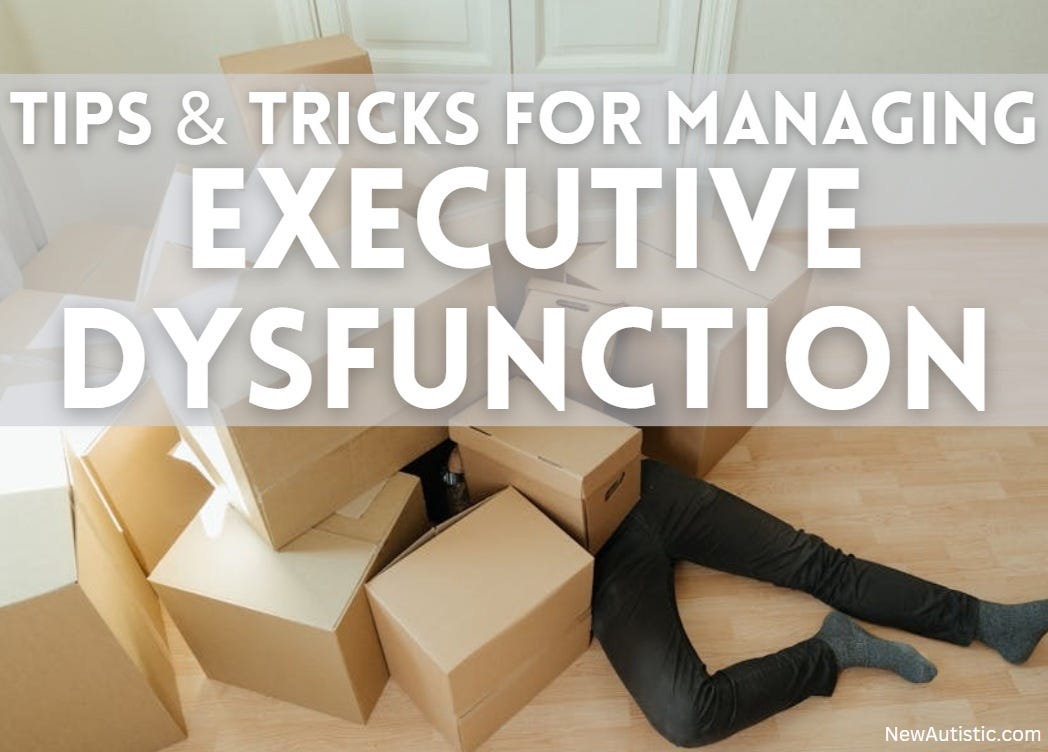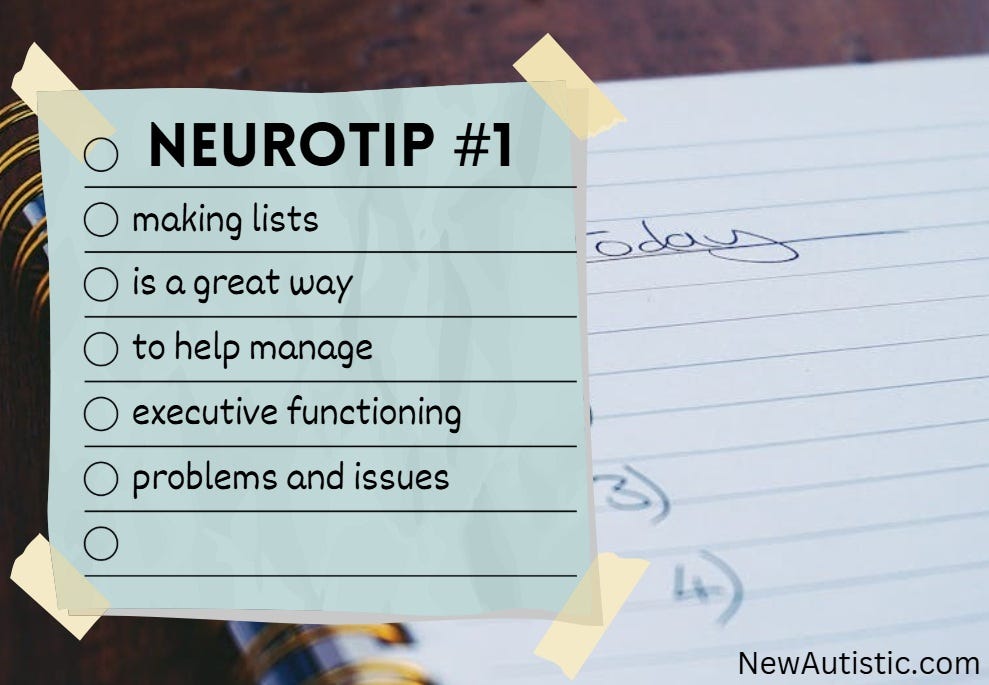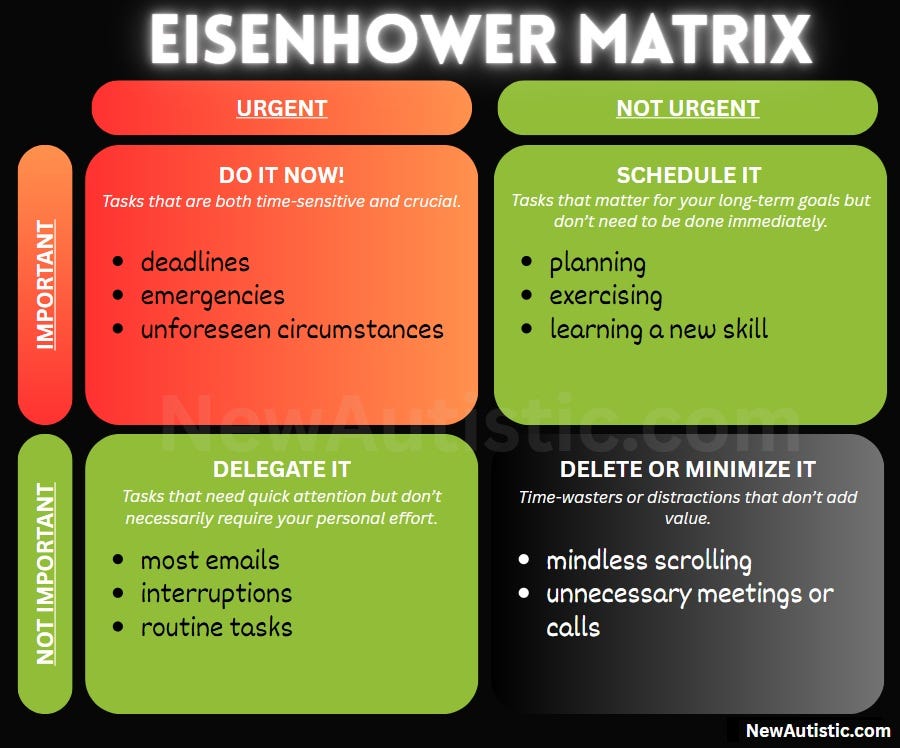Tips & Tricks for Managing Executive Dysfunction
Sticky Notes, Timers, and Chaos: A Survival Guide for the Scattered Mind
Executive dysfunction is a common symptom of both Autism Spectrum Disorder (ASD) and Attention-Deficit/Hyperactivity Disorder (ADHD), but it can and does happen to everyone at some point in their lives. Have you ever had an exceptionally long day at work and forgot to pick up a gallon of milk on the way home? That’s executive dysfunction—albeit on a much smaller scale.
In this article, I’ll cover what executive dysfunction is, how it might present itself, and then offer a number of tips and tricks that I’ve learned living with previously undiagnosed autism and ADHD that helped me manage it. Even if you aren’t on the spectrum, you might learn a few productivity hacks!
I’d also like to take this time to point out that your disorders are yours to manage. You don’t get to keep forgetting your sister’s birthday year after year after year and then fall back on the “I can’t help it! I have ADHD!” excuse. You may have ADHD. Yes, it does make it more difficult to remember things like birthdays and anniversaries. That being said, there are a ton of resources available to people nowadays like calendars, Google alerts, and phone reminders to ensure that you don’t forget important events, dates, and times. Your disorders are not your fault, but they are your responsibility to manage.
Now, with that being said…
What is Executive Dysfunction?
Executive dysfunction refers to difficulties with brain functions regarding planning, focusing, remembering instructions, and managing multiple tasks. These skills (unsurprisingly referred to as executive functions) are crucial for organizing thoughts, making decisions, and achieving goals.
The three main executive functions are working memory, cognitive flexibility, and inhibition control:
Working memory helps you hold and use information in the moment. It’s essential for tasks like following instructions, taking notes, or holding a conversation—anything that requires active, short-term mental focus.
Cognitive flexibility (also known as flexible thinking) is your brain’s ability to adapt, shift between ideas, and respond to change. It supports creativity and problem-solving by allowing you to make connections between different concepts and adjust to new situations.
Inhibition control is the ability to manage impulses, emotions, and behaviors. It includes behavioral control (stopping yourself from acting on urges) and interference control (staying focused and tuning out distractions, including your own thoughts).
Together, these functions help you stay organized, focused, and able to respond effectively to daily demands. For those who struggle with executive dysfunction, even simple tasks can become much more difficult to tackle, taking up a ton of focus and energy just to stay on track.
What are Potential Signs of Executive Dysfunction?
Some potential signs of executive functioning issues in might include:
difficulty staying focused or completing tasks
trouble making decisions
poor impulse control
emotional outbursts or frustration
disorganization at home or work
losing track of personal items
inability to follow instructions or manage time (also referred to as time blindness)
Executive dysfunction can manifest in a variety of ways, so understand that this is by no means an exhaustive list of potential signs. Speak with a medical or healthcare professional if you think you might struggle with executive dysfunction.
Tips & Tricks for Managing Executive Dysfunction
If you struggle with executive functioning issues (like I do), there are a number of tips and tricks I’ve learned that can help you. Of course, not every suggestion will work for every person, but I recommend trying a few out and seeing which ones help you the most. Combining techniques can also lead to improvements in executive function; you just have to figure out which ones work best for you!
Use Visual/Audio Reminders
I am a huge proponent of using visual or audio cues and reminders to help me remember to do—or not do—a huge variety of things. This concept is referred to as externalizing working memory and is commonly seen in autistic and ADHD people. For example, if I need to remember to schedule a dentist appointment but don’t have the time to do it right away, I’ll put a sticky note on my laptop keyboard reading “dentist appointment.” That way, when I sit down later, I’ll be reminded that I need to do that before I do anything else.
Audio reminders are also helpful, like having a certain ringtone for certain tasks. Most smart phones nowadays are able to customize alarms, which means that if you need to let your dogs out around noon everyday so they don’t go potty in the house, you could set up an alarm that plays “Who Let the Dogs Out?” by the Baha Men at 12 PM daily. It’d be an obvious audio cue to go let your dogs out!
I also use visual reminders as a way to remember not to do something. For example, I often forget when I start the dishwasher and have inadvertently opened it in the middle of the cycle several times, interrupting the washing process. To prevent this, I started hanging a spray bottle on the handle of the dishwasher. Why? Because it’s bizarre to see a spray bottle hanging there and it makes me stop before I mindlessly open the dishwasher. I see the bottle, remember that the washer is running, and then am sure not to open it mid-cycle.
Chunking
Chunking is the super-technical term that refers to breaking down larger tasks into smaller, more manageable tasks. For example, if we look at a given task of “cleaning the kitchen,” there are actually a number of smaller tasks within, including:
wiping down the countertops and appliances
doing the dishes
cleaning out the sink
taking out the trash and replacing the trash bag
sweeping and mopping the floor
…and probably several other tasks I’m overlooking as well. So, if we were to chunk the overall task of “cleaning the kitchen,” it might be easier to make a list like the bullet points above and check them off as you go to make the whole task seem less daunting.
🧠 NeuroTip: I found a great resource for chunking called goblin.tools. It’s an app that clearly lays out the steps needed to complete tasks, even for larger tasks like moving or finding a new job. Give it a try and see what you think!
Set Yourself Up for Success
I know this sounds like some new-agey mumbo jumbo, but hear me out: the goal here is to make success as easy for yourself as possible. For example, if your goal is to stop spending so much money eating out, do a big meal prep day before the work week starts. That way, you have lunches to bring with you to work (or even to eat at home), and that can help reduce the compulsion to swing by McDonald’s during your lunch break because it’s “easier.”
For myself, I try to get my workout gear set up the night before. If I want to go swim laps the next morning, I’ll get my bag packed with my swim gear, a towel, and a change of clothes. I’ve noticed that I’m far more likely to go swimming if I’ve made it easy for myself to go rather than if I have to pack my gear in the morning. I’ve heard others say that they put their packed gym bag in the backseat of their car so that they’re more likely to swing by the gym after work.
Take Breaks
In an almost counter-intuitive way, it can be helpful to plan out scheduled breaks if you struggle with executive dysfunction. This is a well-known technique called the Pomodoro Technique, and it works very well for a large subset of people. Here is a breakdown of the technique:
Identify Tasks: List out the task(s) you need to complete.
Set the Timer: Set a timer for 25 minutes.
Focused Work: Work on your task(s) without distractions during for 25 minutes.
Short Break: Take a 5-minute break when the timer goes off.
Repeat: Repeat the 25-minute work and 5-minute break intervals four times.
Longer Break: After four "pomodoros," take a longer break of around 15-30 minutes.
Repeat: Repeat the cycle until completion.
You can vary the times to suit your needs, like working for 15 minutes and taking 10-minute breaks instead. As I said earlier in this article, it’s about finding what works for you!
Make Lists
Externalizing working memory (read: making lists) can be a great way to help manage executive dysfunction. Personally, I love using Google Keep as a list keeper for grocery, hardware, and other shopping. I have separate lists for different stores and even have one that I use as a storage tank for gift ideas for friends and family. I also like to group (or chunk) my grocery shopping lists into sections like fresh produce, meat, dairy, canned goods, etc. as that helps me manage shopping much more easily.
Lists are also great for keeping track of things that you need to take care of, like scheduling doctor or dentist appointments, renewing your auto insurance, or calling your grandmother on her birthday. I keep a notepad on my desk so I can jot down tasks that need to be done in the future, and since it’s kept on my desk, I have to look at it just about every day until the task gets crossed off the list.
“Just 10 Minutes”
Another technique that has worked quite well for me is something I call “Just 10 Minutes.” There are so many tasks and chores that I hate doing, or even situations that feel extremely overwhelming to the point where I can barely even wrap my brain around starting them.
In cases where I am very averse to doing something for whatever reason, I tell myself that I’m going to do whatever unpleasant task I’ve been putting off for “just 10 minutes.” Yeah, I know I don’t want to clean the bathroom, but let’s get started on it and I can stop after I’ve been working for 10 minutes. When I was in school, it was more about doing homework I didn’t want to do, or starting to study for a class that I wasn’t thrilled about.
What often happened, however, was that after "just 10 minutes,” I typically had garnered up enough inertia to keep rolling on the task; getting started had been the hardest part.
🧠 NeuroTip: If you’re struggling with something exceptionally difficult, try adjusting the rule to “Just 5 Minutes” and see if you can get the ball rolling with that.
Limit Multitasking
Trying to do too many things at once is a great way to end up doing nothing well. Many studies have shown that multitasking is detrimental to focus and output even in neurotypical people. I’d argue the effect is magnified in those with autism and ADHD, especially because we can find switching from one task to another very difficult.
If you do have several things that you need to attend to, consider setting aside chunks of time in which you will dedicate all your focus on a singular chosen task. For example, instead of trying to clean the kitchen, bathroom, and bedroom all at the same time, it might be easier to focus on one room at a time, or even one task at a time (ie. laundry, sweeping, or wiping down counters).
Effectively Prioritize Tasks
One of the best ways to help get your executive dysfunction under control is to learn how to effectively prioritize tasks. If you have a list of 50 tasks you need to attend to, it might seem wise at first to start at the top and work your way down. But what if some of the tasks are time-sensitive? Are all of the tasks the same level importance, or are some okay to sit for a while?
A great tool for task prioritization is the Eisenhower Matrix, which I’m sure some of you have heard of before. Also known as the Urgent-Important Matrix, this is a simple decision-making tool that helps you prioritize tasks based on their urgency and importance. It’s named after U.S. President Dwight D. Eisenhower who was known for his productivity and effective time management. The matrix is divided into four quadrants:
Urgent and Important: Do it now! These are crucial, time-sensitive tasks like deadlines or emergencies.
Important but Not Urgent: Schedule it. These are tasks that matter for your long-term goals, but don’t need to be done immediately (like planning, exercising, or learning a new skill).
Urgent but Not Important: Delegate it. These tasks might need quick attention, but they don’t necessarily require your personal effort (like most emails, interruptions, or other routine tasks).
Not Urgent and Not Important: Delete or minimize it. This quadrant will have time-wasters or distractions that don’t add value to your life (like mindless scrolling, or unnecessary meetings or calls).
Using an Eisenhower Matrix helps you focus your time and energy on what truly matters instead of just reacting to whatever feels most urgent. Give it a try today!
Automate Tasks
Automating tasks can make it so you don’t have to devote extra mental effort to remembering to do things. For example, if you’re having trouble remembering to pay your credit card or utility bills on time, consider setting up automatic payments so that the bills always get paid. I set up automatic payments or most of my bills so that I never forget!
You can also automate updates for your phone, tablet, computer, gaming devices, and more. Scheduling them for times you’re likely to be sleeping tends to work best so that you don’t keep putting off the updates indefinitely.
Find Routines That Work For You
This wouldn’t be an article about autism if I didn’t mention routines, would it? Routines can be a powerful tool for managing executive dysfunction because they reduce the mental load required to both make decisions and remember what needs to be done.
When tasks become part of a predictable daily rhythm, they require less active planning and fewer executive resources to complete. For example, having a set morning routine—like brushing your teeth, taking medication, and drinking a big glass of water in the same order each day—can help reduce forgetfulness and increase efficiency.
Routines also create external structure, something that is especially helpful for autistic and/or ADHD people who struggle with initiating tasks or transitioning between them. By automating parts of your day through consistent habits, you conserve mental energy and leave more brainpower for the things that require more of your flexibility and focus.
Consider Professional Support
I understand that not everyone has the means to afford therapists and coaches, but if you do and you think it might be beneficial for you, consider hiring a therapist or coach. These trained professionals are specialized in offering additional resources to help you learn to manage executive functioning issues, along with a number of other issues relating to neurodiversity.
That being said, if you find a coach or therapist who allows you to get away with everything because “you have autism” or “you have ADHD,” I’d suggest finding another therapist. They shouldn’t be mean to you, but they should be holding you accountable and encouraging progress and growth.
Be Kind to Yourself
“I can’t believe you forgot to do something so simple! Did you seriously drive all the way to work without your work laptop? Even a child could remember to bring all their stuff to school! What’s wrong with you?!”
Perhaps to some of you, these thoughts might sound foreign and cruel, but to many of us with executive dysfunction (and/or perhaps less than ideal upbringings), they’re all too common.
It’s easy to become frustrated with yourself when you forget or make mistakes. We’re often our own worst critics, beating ourselves up internally. And yet, if a friend made a similar mistake, we wouldn’t dream of belittling them in the same way. So why is it okay that we do it to ourselves? The answer is that it’s not, and we should endeavor to be kinder to ourselves when we do inevitably make mistakes—because we all do.
Instead of beating yourself up, be proactive about the solutions going forward. If you are the person who drove to work without their work laptop for the fifth time, consider putting your car keys on top of your work laptop. That way, you’ll be reminded to grab your laptop before you leave for work. Remember that mistakes aren’t the problem; it’s changing your behavior going forward that counts.
Final Thoughts (Before I Forget What I Was Saying…)
Executive dysfunction can be frustrating, exhausting, and at times downright defeating—but it’s not a personal failing. Whether you’re neurodivergent or just having a rough week, struggling with executive function doesn’t make you lazy, broken, or incapable. It simply means your brain needs a bit of extra support and strategy.
The good news is that there are ways to work with your brain instead of against it. From reminders and routines to tools and techniques, you can build systems that lighten the mental load and help you get things done with a little less stress. Will you still forget things sometimes? Absolutely! But you’ll also get better at catching yourself, adapting, and moving forward with more grace and less guilt.
So try out some tips, tweak what doesn’t work, and celebrate what does! Let us know in the comments below what works best for you :). Progress doesn’t have to be perfect; it just has to keep going.
… and hey, maybe write down your sister’s birthday right now? Y’know, just in case!
Thanks for Reading!
Thanks for taking time out of your busy day to spend some time with me! I encourage all of my readers to RISE (Reflect, Improve, Strengthen, & Evolve) with me because healing is a lifelong journey — it’s not always easy, but it’s always worth it. You are loved, cherished, and valued. Don’t ever let anyone ever convince you otherwise.
My commitment to bringing you FREE, well-researched, and comprehensive content means I spend considerable time and effort writing each article or post without compensation.
Want to Support Me?
The simplest FREE way you can support me is by subscribing, sharing, or leaving a comment:
I believe in keeping my content accessible to everyone, without paywalls, because I know the work I do matters. For that reason, I’m beyond grateful for any financial support! If you'd like to support me and my work, check out my art website at AriesArtwork.com to bring home something unique or find a gift for that special someone in your life:
I’ll see you again when I’ve got a new info-dump for you, my Newtistics Crew!
—Skylar Aries






